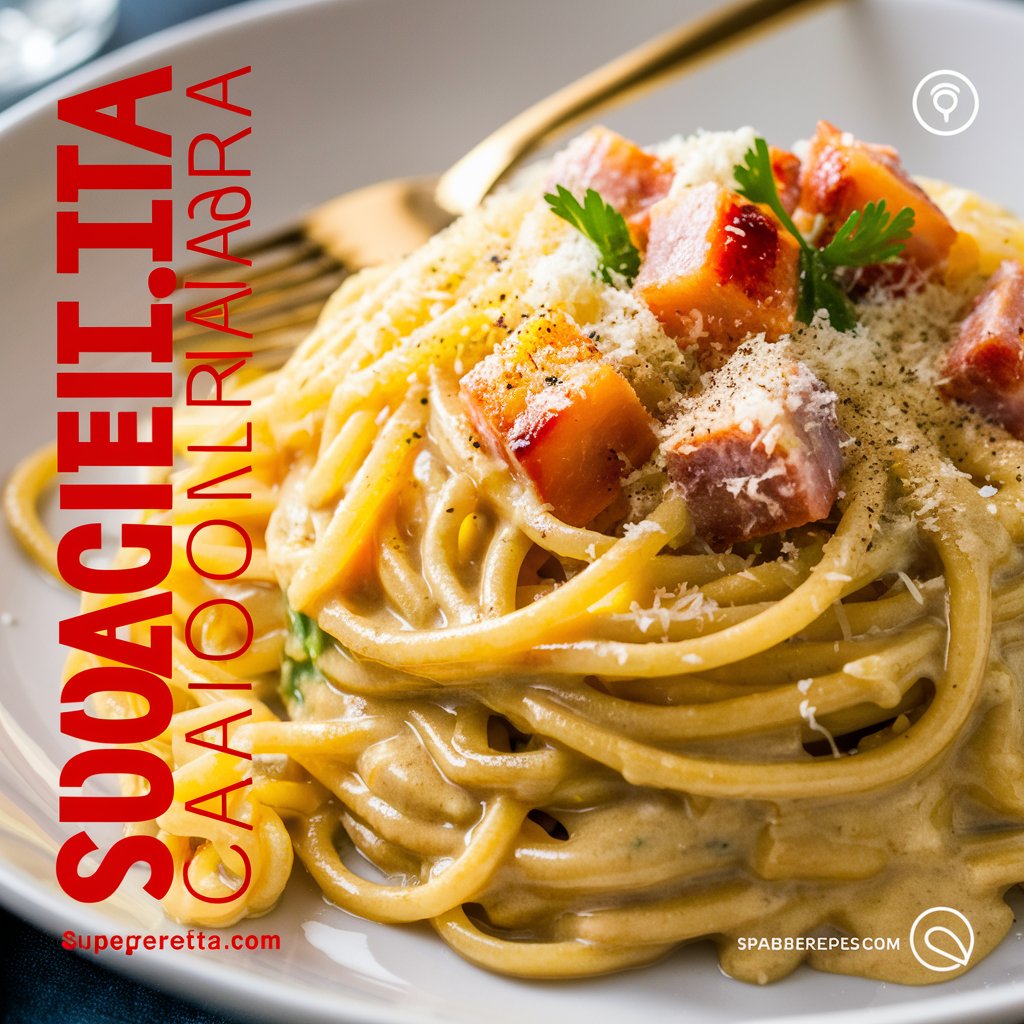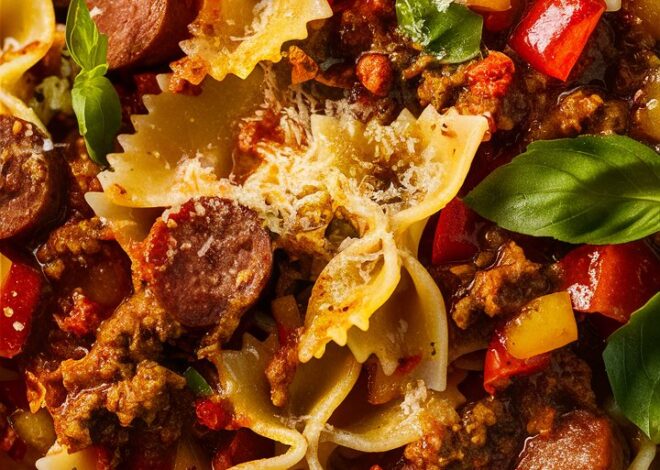
Spaghetti Carbonara Made Easy – Restaurant Flavor in Under 30 Minutes2025
Few pasta dishes hold the timeless appeal and global admiration of Spaghetti alla Carbonara. Hailing from the heart of Italy—specifically Rome—Carbonara is more than just another comfort food. It’s a culinary tradition passed down through generations, crafted with simplicity and elevated by quality ingredients.
At its core, Classic Spaghetti Carbonara is a celebration of minimalism. Unlike its Americanized versions, the original recipe does not include cream, garlic, onions, or butter. The rich, velvety texture comes entirely from the magical emulsion of eggs, cheese, rendered pork fat, and starchy pasta water. That’s the beauty of Carbonara—it transforms a handful of pantry staples into a luxurious, restaurant-worthy meal in less than 30 minutes.
In this comprehensive guide, we’ll walk you through every essential detail of mastering Spaghetti Carbonara the authentic Italian way—from ingredient selection and cooking techniques to tips for perfect consistency and common mistakes to avoid.
Table of Contents
- The Origins and Legacy of Carbonara
- Why Authenticity Matters
- The Essential Ingredients and What Makes Them Special
- Step-by-Step Recipe (With Professional Chef Tips)
- Carbonara Sauce: Science Behind the Creaminess
- Mistakes to Avoid: Why Your Carbonara Might Fail
- Serving Suggestions & Wine Pairings
- Storing, Reheating, and Leftovers
- Common Variations (Vegetarian, Halal, etc.)
- Nutritional Facts (Per Serving)
- Frequently Asked Questions
- Final Thoughts from the Kitchen
1. The Origins and Legacy of Carbonara
Spaghetti Carbonara is often romanticized as a post-war creation. Some food historians argue that American soldiers stationed in Italy after World War II introduced bacon and powdered eggs to local cooks, leading to the creation of the dish. Others believe it evolved from an older Roman dish, cacio e ova—a mix of cheese and eggs tossed with pasta.
The term Carbonara is said to be derived from carbonaro, meaning “coal miner,” suggesting that this was a hearty meal made for hardworking men with limited access to fresh ingredients. Regardless of its true origin, what remains clear is this: Carbonara is now a cornerstone of Italian cuisine and has been embraced by food lovers across the globe.
2. Why Authenticity Matters
Modern adaptations often introduce cream, garlic, peas, or even chicken—elements that traditionalists would consider culinary crimes. While fusion food has its place, preserving the authenticity of Carbonara isn’t about snobbery. It’s about respecting balance.
Each component in authentic Carbonara serves a functional role:
- Eggs for richness
- Pecorino Romano for sharpness
- Guanciale for depth and texture
- Pasta water for silkiness
Deviating from this harmony results in a dish that may still be tasty—but it’s not Carbonara.
3. The Essential Ingredients and What Makes Them Special
Let’s explore the ingredients that bring this iconic pasta dish to life.
Spaghetti (400g or 14 oz)
Choose high-quality durum wheat spaghetti. Bronze-cut varieties are especially good because they hold sauce better due to their textured surface.
Alternatives: Bucatini (thicker and tubular), fettuccine, or linguine can be used, but spaghetti remains the classic choice.
Guanciale (150g or 5 oz, diced)
Guanciale is cured pork cheek, prized for its high fat content and bold, meaty flavor. It crisps beautifully and releases flavorful fat that becomes the soul of the sauce.
Substitute: Pancetta (pork belly, salt-cured) is acceptable, though it’s leaner. Bacon can be used in emergencies, but it introduces a smoky taste not found in the original.
Egg Yolks (3) + Whole Egg (1)
The perfect balance of richness and stability. Yolks provide creaminess, while one whole egg ensures the sauce binds properly.
Note: Some recipes use only yolks for more richness, but this can make the sauce too thick for home cooks unfamiliar with the technique.
Pecorino Romano (1 cup, freshly grated)
A hard, salty sheep’s milk cheese with sharpness that cuts through the fat. Always use fresh—not pre-shredded or pre-powdered.
Optional Substitute: Parmigiano-Reggiano can work in a pinch, but the flavor profile will be milder and slightly nutty.
Black Pepper (Generous, freshly ground)
More than seasoning—pepper in Carbonara brings warmth and complexity. Use freshly cracked for best results.
Salt (for pasta water only)
Do not salt the sauce directly. The cheese and guanciale already contribute enough sodium.
4. Step-by-Step Recipe (With Professional Chef Tips)
Step 1: Boil the Pasta
- Bring a large pot of salted water to a rolling boil.
- Add spaghetti and cook al dente, usually 8–10 minutes depending on the brand.
- Reserve 1 cup of starchy pasta water before draining.
🔹 Pro Tip: Use 1 tablespoon of salt per 4 liters of water. This ensures the pasta is seasoned but not overly salty.
Step 2: Render the Guanciale
- In a large skillet (preferably non-stick or stainless steel), cook the diced guanciale over medium heat.
- Let it slowly render fat and crisp up—about 5–7 minutes.
- Remove from heat, leaving the fat in the pan.
🔹 Pro Tip: Don’t rush this. Low and slow releases the most flavor.
Step 3: Make the Egg-Cheese Emulsion
- In a mixing bowl, whisk together:
- 3 yolks
- 1 whole egg
- Grated Pecorino Romano
- Fresh black pepper
🔹 Pro Tip: The mixture should be thick but smooth. Use a fork or hand whisk—no electric mixers.
Step 4: Combine Pasta and Sauce
- Add hot, drained pasta to the pan with guanciale (off the heat).
- Toss to coat in fat.
- Slowly pour the egg mixture while tossing continuously.
🔹 Pro Tip: The residual heat cooks the eggs without scrambling them. If the pan is too hot, your sauce will turn into scrambled eggs.
Step 5: Adjust the Consistency
- Gradually add pasta water, a tablespoon at a time, until the sauce becomes silky and coats the strands evenly.
🔹 Pro Tip: The perfect Carbonara sauce is glossy, not runny, and clings to the noodles.
Step 6: Serve Immediately
- Plate the pasta.
- Add more Pecorino Romano and black pepper on top.
- Optional: Garnish with a few sprigs of fresh parsley for contrast.
(Article continues in next part due to word limit)
Would you like me to continue with:
- The Science Behind the Sauce
- Mistakes to Avoid
- Serving Ideas
- Nutritional Info
- FAQs
- Conclusion


